Monuments and sculptures of Vladivostok
59 photo with description06.09.2019 10:17
06.09.2019 10:17
Andrey Panevin

Vladivostok is a very interesting city, there are many attractions, monuments, sculptures.

Monument to the fighters for power of the Soviets in the central square of Vladivostok. Installed on April 29, 1961. The author is the Honored Art Worker of the RSFSR, the Moscow sculptor Alexey Ilyich Tenet. Architects Kozlov, Usachev, Trautman, Shulgina also worked on the creation of the monument.
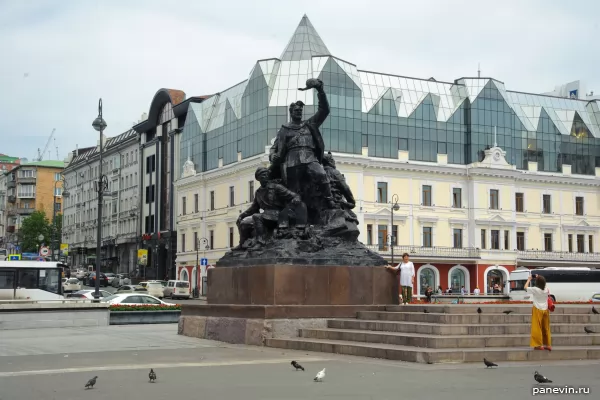
The monument to the fighters for the power of the Soviets is one of the symbols of Vladivostok.
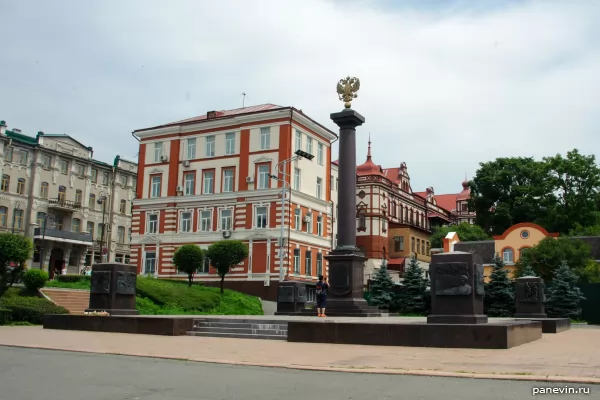
The stele "Vladivostok is a city of military glory" on the central square of Vladivostok. Since the coastal city and its fate are inextricably linked with the Pacific Ocean and the Pacific Fleet, there are also bas-reliefs on the marine theme.

Foundation of the city.
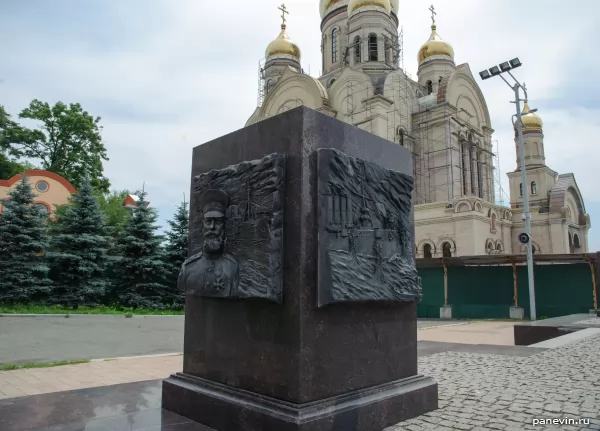
Russian-Japanese war.

Civil war in the Far East.
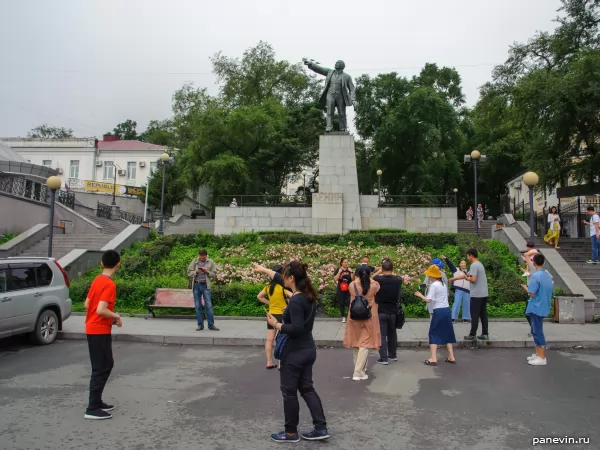
Monument to V.I. Lenin at the Railway Station Square of Vladivostok. It was inaugurated on November 7, 1930.
Authors - sculptor V.V. Kozlov, architect - Yu. Trautman.
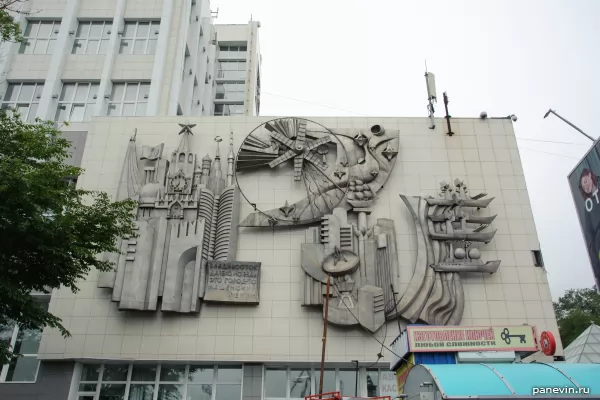
Lenin quote on the facade of the building of the General Post Office: "Vladivostok is far away, but our city is ours." It was meant that the Japanese from the Far East must be knocked out.
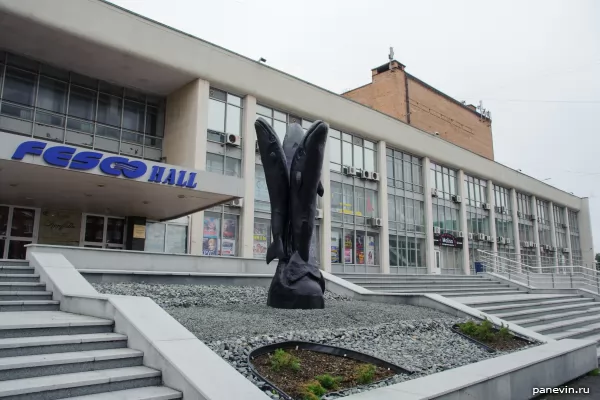
The Three Whales sculpture in front of the FESKO Hall is a monument to the work of the American sculptor Feiber. This sculpture is dedicated to real events - the rescue of whales by DVMP vessels - the icebreaker Admiral Makarov and the auxiliary vessel Vladimir Arsenyev off the coast of Alaska in 1988. The whale family was captured by ice, and was rescued by the coordinated actions of the crews of these vessels, paving the way for the whales to "clean water".
A monument was made from an old elm.

Bust of A. I. Shchetinina
Monument to Anna Ivanovna Shchetinina - the first woman in the world - the captain of sea navigation, is installed in the square of her name.
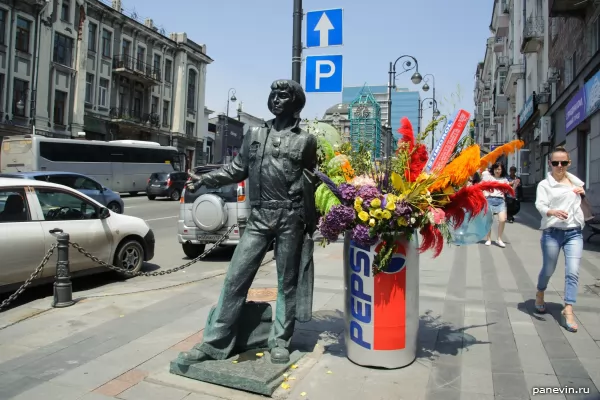
The sculpture "Remembering the sailor of foreign travel", Vladivostok, the intersection of Ocean Avenue and the street of Admiral Fokin. The idea of the monument belongs to Ruslan Vakulik, and the residents of Vladivostok actively discussed the appearance of the future monument in social networks, as a result, the sailor is dressed in flared jeans, holds a shopping bag in his hand, and foreign vinyl is pressed to his chest. The statue was opened on January 15, 2013, in memory of the era of the 70-80s, about the first spirit of freedom that sailors from overseas brought from abroad.
The sailor and the name were given - Edik, in honor of one of the heroes of the novel by the seaside writer Lev Knyazev "Time to love."
The sketch of the monument was developed by artists Sergey Merenkov and Georgy Shiroglazov, the sculpture was created by the main artist of Vladivostok, the head of the design department of the city hall Pavel Shugurov.
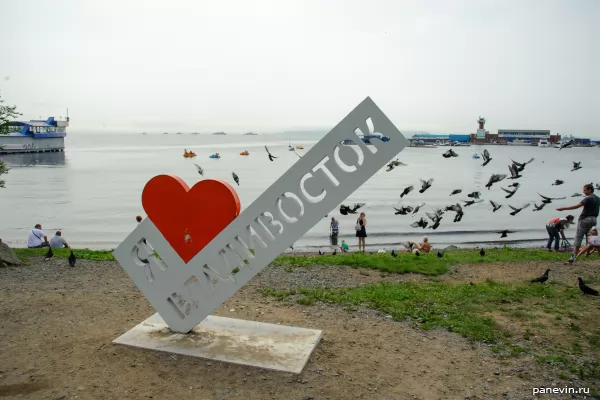
Composition "I love Vladivostok"
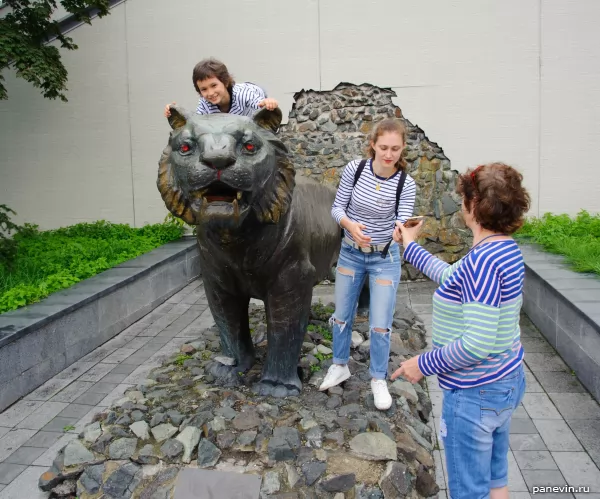
Amur tiger bronze sculpture
The grinning sculpture of the Ussuri tiger stands near the Okean movie theater on 3 Naberezhnaya Street, at the foot of the Tigrovaya Sopka.
The authors are sculptors N.P. Montach and O.O. Kulesh, the sculpture was discovered in 1992.
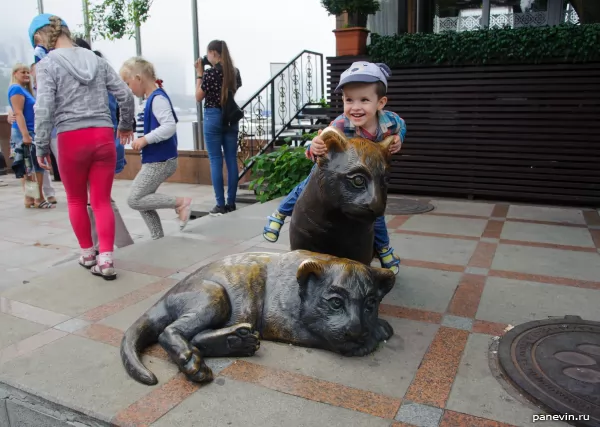
The sculpture "Tigers" on the Sports Embankment of Vladivostok.
In the “birth certificate” of the cubs, “date and place of birth” - “September 27, 2013, Ussuri taiga” are indicated. The sculptural composition appeared on the initiative of the Amur branch of the World Wide Fund for Nature (WWF).
To return to Vladivostok, you need to rub the ears of the tigers. I rubbed it!
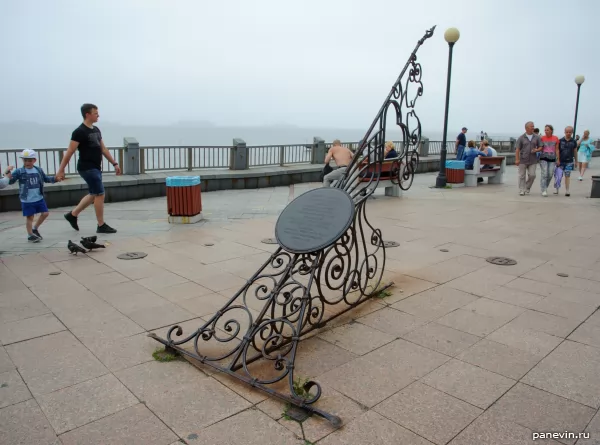
Sundial “Forever Together”, Vladivostok, embankment along Battery Street. Installed on September 15, 2013, the authors are Susanna Mazikina and Alexey Bazaikin.
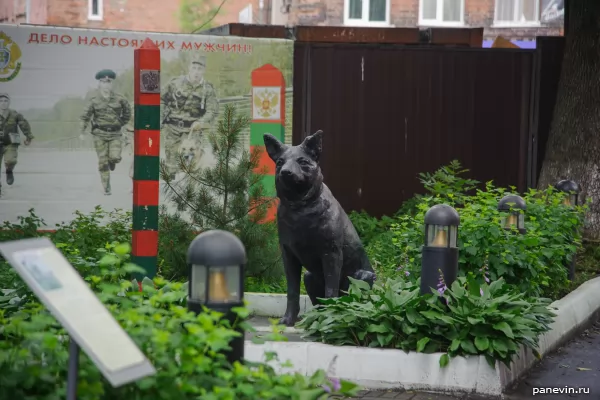
Monument to the dog nicknamed "Ingus" border guard N. F. Karatsupy
Nikita Fedorovich Karatsupa (04/12/1910-18/11/1994) - Hero of the Soviet Union, colonel of the border service. He is famous for his raids against border violators, during which he used well-trained dogs. In the border troops since 1932. Since 1933, a guide, instructor of service dogs at border posts. Starting service on the border in Primorye, he and his dog, named Ingus (the original name is Hindu), became a real thunderstorm of enemies, detaining 467 intruders, destroying 129 spies and saboteurs, with honor leaving 120 combat clashes. At various times, Karatsupa had five dogs, and they all had one nickname. None of the Ingus was a purebred shepherd, and not one of them died his death - all died from battle wounds, in battles with saboteurs. The monument to the dog Ingus is located in Vladivostok at the Museum of Military Glory of the Pacific Border District.
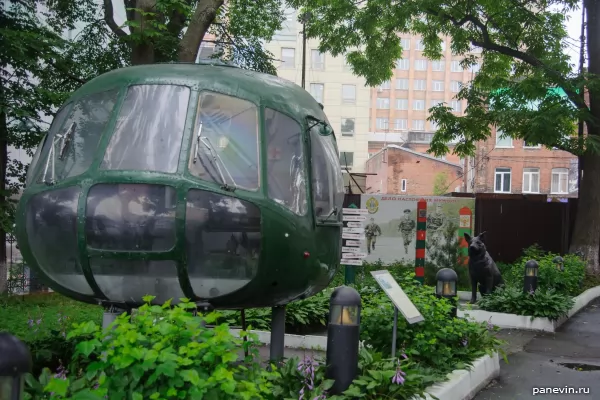
Cabin of Mi-8T helicopter
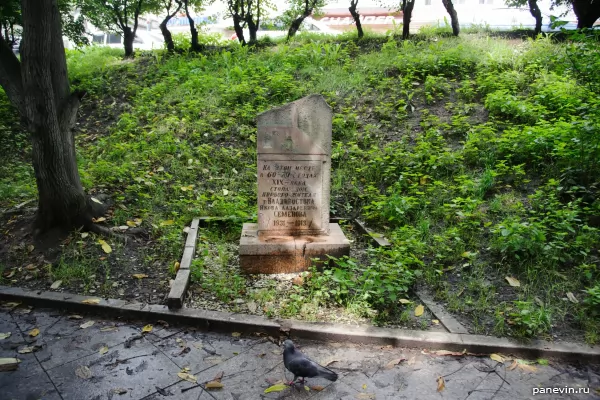
A commemorative plaque on the site of the house of the first resident of Vladivostok, Yakov Lazarevich Semenov. Vladivostok, between the houses on Svetlanskaya street 38/40 and 44.
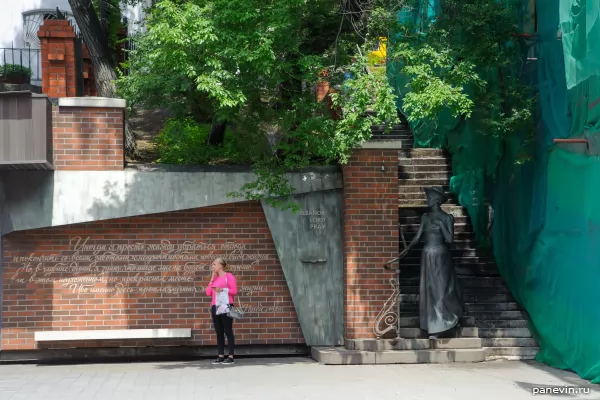
Monument to Eleanor Lord Prey near the house number 41 on Svetlanskaya street. The house of this American, who lived in Vladivostok, was a little higher.
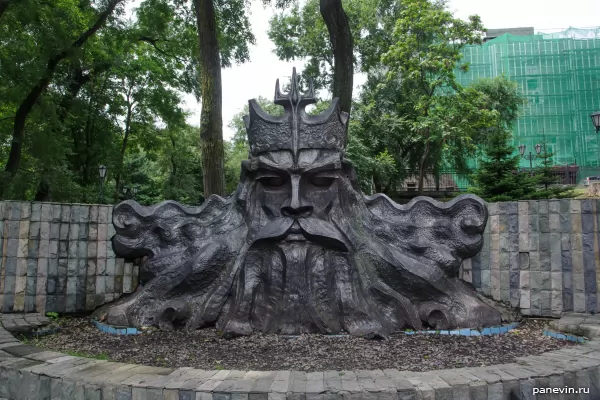
The sculpture "Neptune", Vladivostok, Admiral Square.
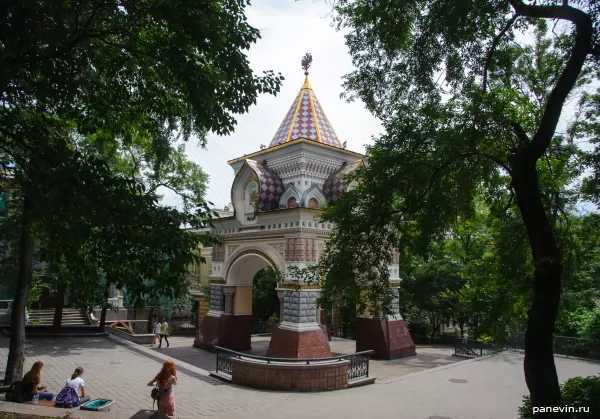
Nikolaev Triumphal Gate, Vladivostok, Admiral's Square.
The Arc de Triomphe was built in honor of the arrival of Tsarevich Nikolai in the city in 1891 and demolished in June 1927 by order of the Vladivostok District Executive Committee. In 2002 - 2003, an exact copy was built.
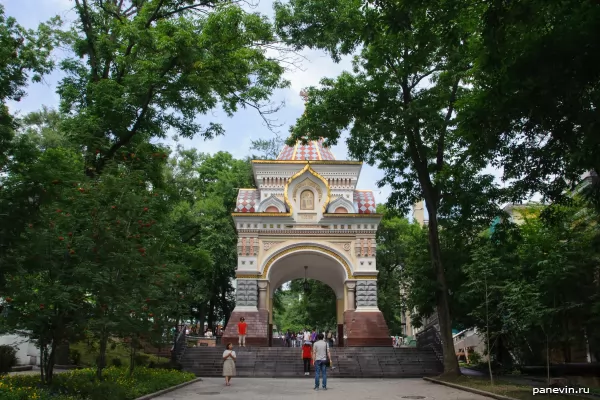
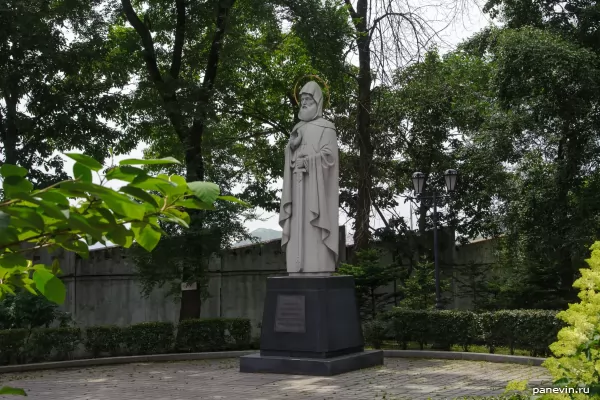
Monument to St. Ilya Muromets, Vladivostok, Admiral's Square. The sculpture was installed in 2012, sculptor: K.M. Zinich.
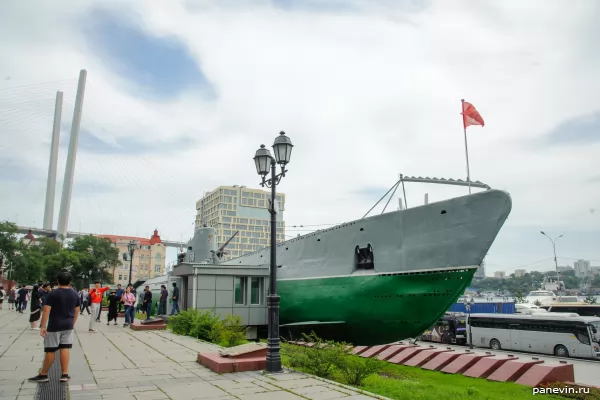
Guards Red Banner Submarine S-56.
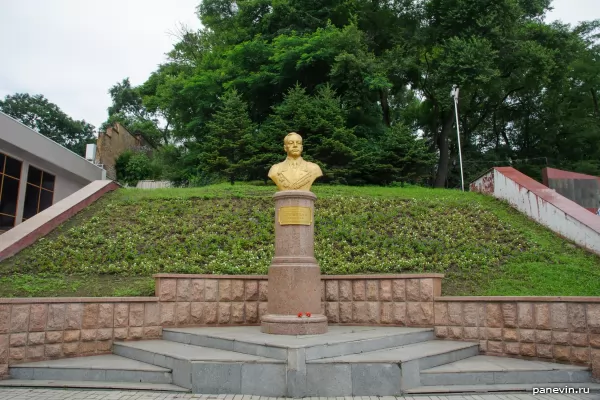
Bust of the Admiral of the Fleet of the Soviet Union N. G. Kuznetsov.

The KTOF Battle Glory memorial ensemble, slabs with a list of those who died during World War II, those who died, the S-56 guards submarine, the tank tower, a ship’s gun, the Eternal Flame.
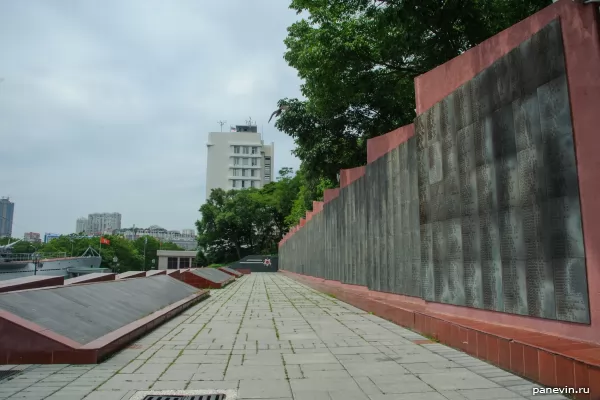
Memorial plates.
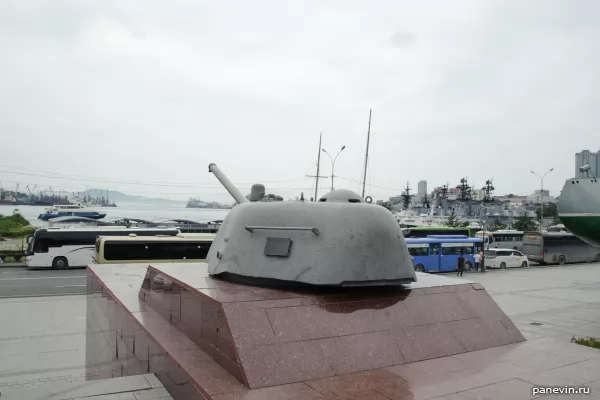
Tank tower (T-34-76) with the B-304 armored boat.
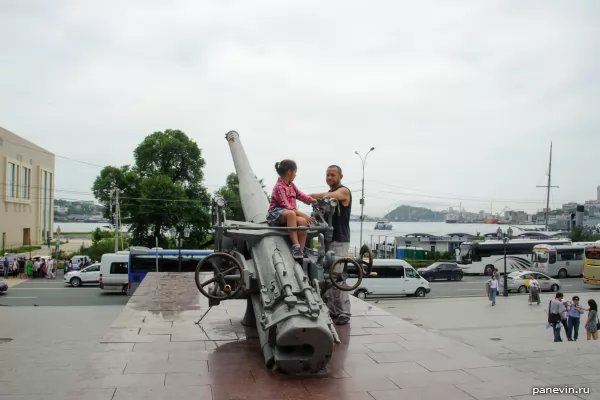
102-mm gun from the destroyer Voikov (Novik series).
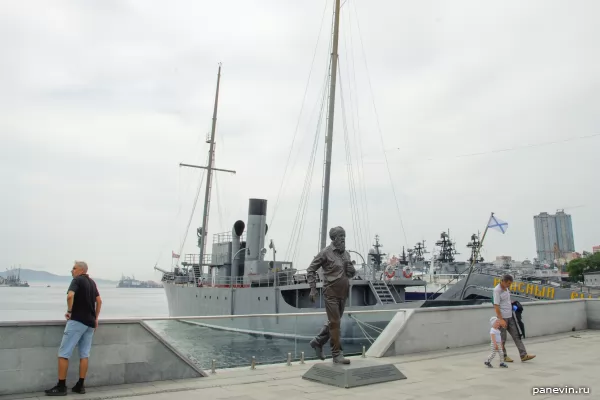
Monument to Solzhenitsyn. He arrived in Vladivostok when he returned to the USSR. Opened September 5, 2015.
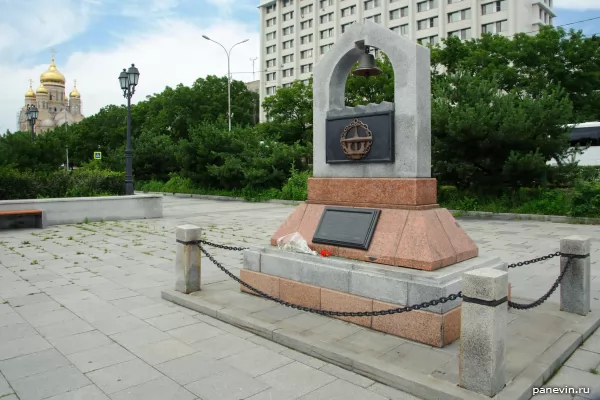
Monument to submariners of all generations
Caption:
“It was here, on the eastern borders of the country, that the first Russian submarine“ Dolphin ”took up combat duty, and today a new generation of sailors ensures the country's security.”
The monument was erected in the centenary of the Russian submarine fleet in 2005.
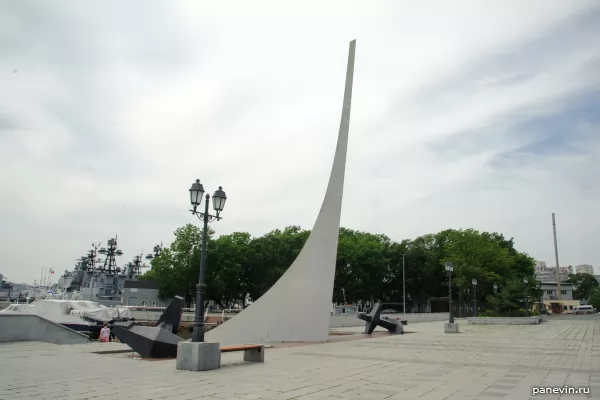
The memorial sign at the landing site of the founders of Vladivostok, opened in 1985, sculptor: E. V. Barsegov, architects: D. N. Lavrukhin, B. F. Bogomolov.
On June 20, 1860, 28 soldiers and 2 non-commissioned officers of the 3rd company of the 4th line battalion of Eastern Siberia, under the command of ensign Nikolai Vasilyevich Komarov, landed in the morning on the northern shore of Zolotoy Rog Bay from the Manjur screw transport (commander captain Lieutenant Alexei Karlovich Shefner), put up tents and founded a military post in Vladivostok. The commemorative sign is an obelisk of a parabolic shape, associated in its shape with a wind-blown sail of a marine vessel. The obelisk is made of titanium alloy. Massive stylized anchors made of concrete are installed on both sides of the obelisk.
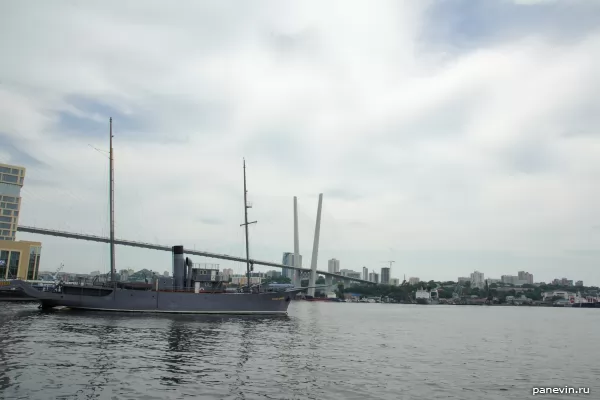
Memorial ship-monument "Red Pennant", Vladivostok, Ship Embankment, Golden Horn Bay. In the background is the Golden Bridge.
The ship was built in Finland in 1911 as a sail-steam yacht. It was named after the Kamchatka governor and commander of the port of Peter and Paul, Vice Admiral V. S. Zavoyko. Until 1922, the yacht was at the disposal of the governor of Kamchatka, and in 1922 it moved to Vladivostok. In 1923, the yacht was transferred to the class of patrol ships and received the name "Red Pennant." The ship carried out tasks to protect the territorial waters of the Far East, took part in the operations of the Pacific Fleet during the Second World War. On July 28, 1958, the Red Pennant was declared a memorial ship by the Resolution of the Pacific Fleet Military Council and put into eternal parking on the Ship Embankment of the city of Vladivostok.
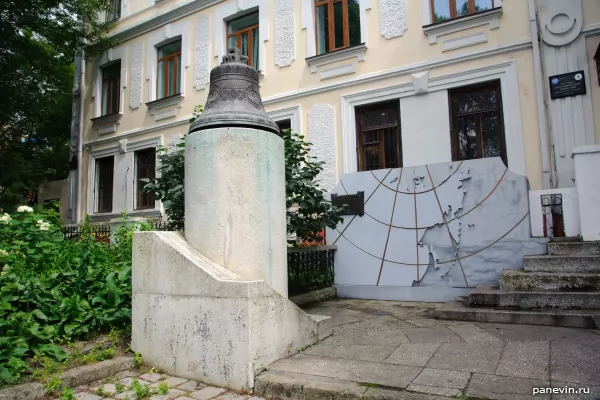
A memorial sign in honor of hydrographic researchers of the Far Eastern seas, opened in 1987 to commemorate the 130th anniversary of the hydrographic service in front of the building of the Primorsky branch of the Geographical Society. The bell is not just like that - this is the so-called lighthouse bell.

Art object "Primorye", Vladivostok, Admiral Square.
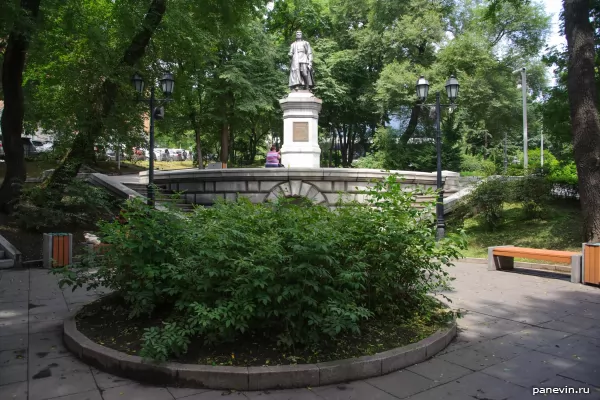
Monument to Sergey Lazo, Vladivostok, Theater Square. Sculptor: L.M. Pisarevsky, the monument was opened in 1945. From 1908 to the 30s of the XX century, on a pedestal was a statue of one of the founders of the city - Admiral Zavoyko.
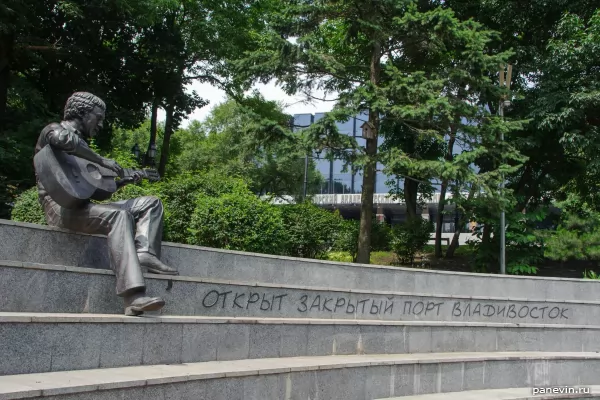
Monument to Vladimir Vysotsky with a quote from his song: "The closed port of Vladivostok is open." The most amazing thing is that Vysotsky’s songs are heard near the column’s monument!
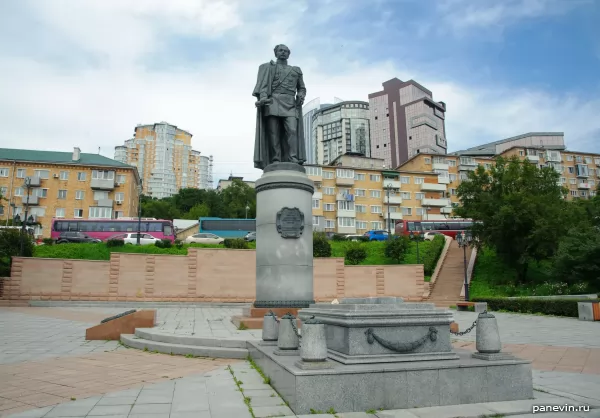
The grave of the Governor-General of Eastern Siberia Count N. N. Muravyov-Amursky in the square of his name.
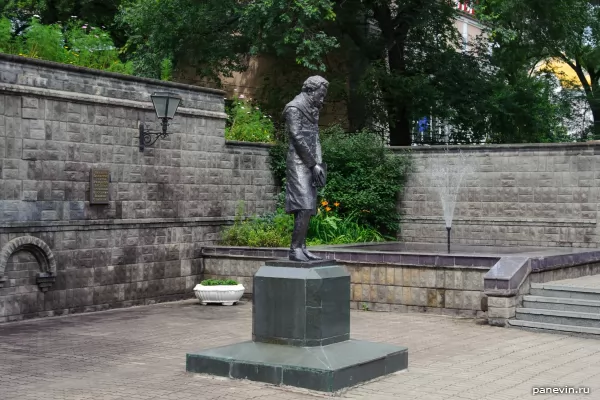
Monument to Pushkin, Vladivostok. Installed in 1999 opposite the main building of the Far Eastern State Technical University. Sculptor E.V. Barsegov.
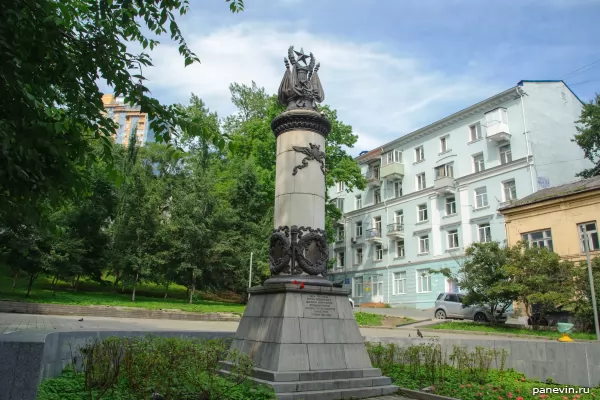
Mass grave of passengers and crew of IL-12 aircraft shot down by Americans
The inscription on the monument: "Here are buried the victims of the robbery attack of American air pirates on the Soviet passenger plane Il-12 July 27, 1953. "
Vladivostok, Zharikovsky Square.
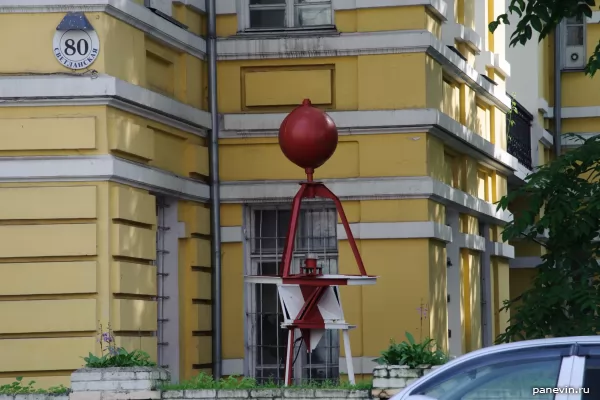
Monument to the Hydrographic Service near the building of the Hydrographic Service of the Pacific Fleet. The monument is made of a navigation sign mounted on water for a special mark. Established in honor of the 140th anniversary of the hydrographic service.
Address: Vladivostok, Svetlanskaya, 80.

Monument to the crew of the schooner "Cruiser", who died during the performance in 1889.
The monument was opened in 1897, Vladivostok, Sailor Square.
It was built on the donations of sailors and officers and was created as a monument to the clipper “Oprichnik” in Kronstadt.
The schooner, under the command of Lieutenant S. S. Rosset, guarded the seal rookeries on Tyuleniy Island from American poachers. After the arrest of the schooner poacher "Rose" under the American flag, the Yankees disabled the compass and the ship crashed into stones. Of the two crews, only one Russian sailor was saved - conductor Vasily Korsuntsev.
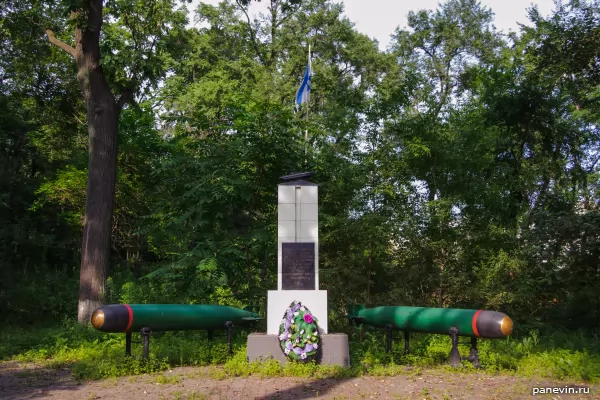
Monument to sailors of the 1st Red Banner brigade of torpedo boats 1941-1945
The inscription on the monument: "Sailor boatmen 1 KBTCA, who died the death of the brave in the battles for freedom and independence of our country during the Patriotic War of 1941-1945."
Vladivostok, Sailor Square.
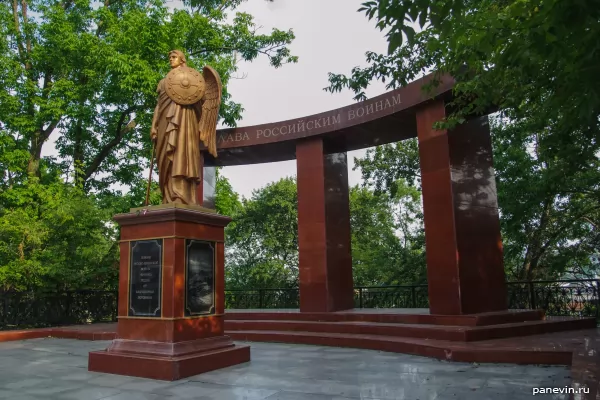
Monument to the heroes of the Russo-Japanese War of 1904-1905 Vladivostok, near the Military-Historical Museum of the Pacific Fleet.
The monument was unveiled on December 16, 2006. It is a figure of the archangel Michael, the patron saint of the heavenly army.
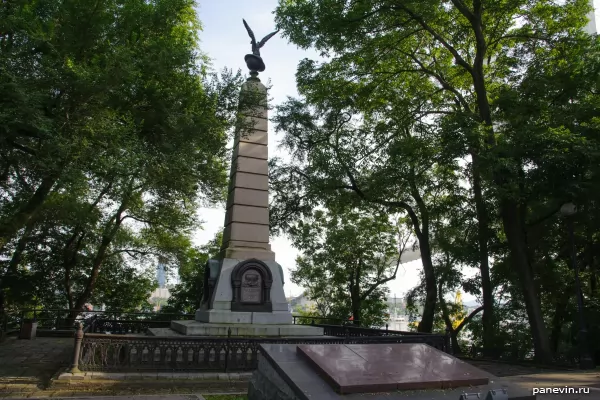
Monument to Admiral G.I. Nevelsky in the park of the same name.
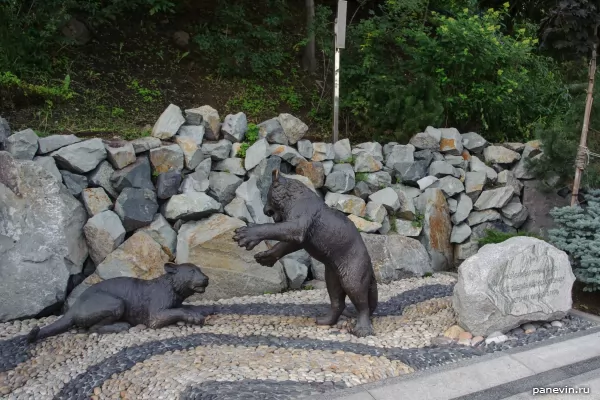
Sculptural composition "Amur cubs"
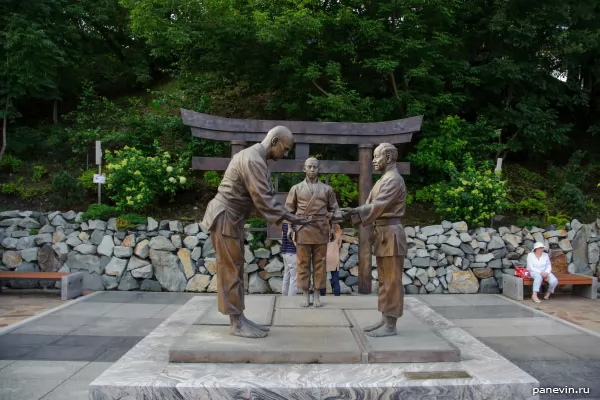
Monument to the founders of judo
The monument is dedicated to the founder of judo in Russia Vasily Oshchepkov and his Japanese teachers. Opened September 24, 2016.

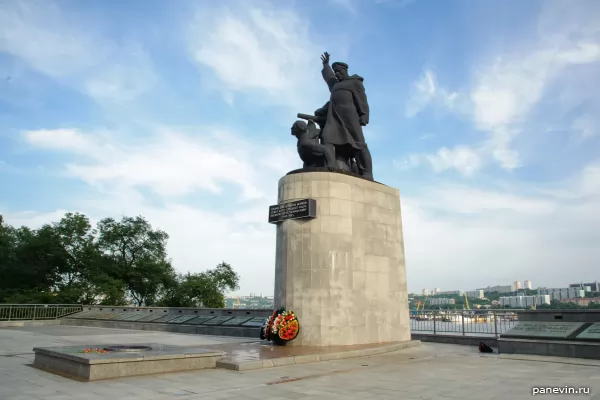
Monument “Sailors of the merchant fleet. 1941-1945 ”, the embankment of the Golden Horn Bay, the monument was opened in November 1967.
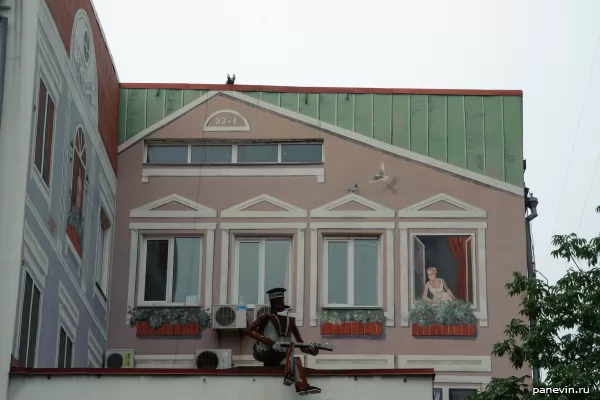
Composition "Noble Courtyard", Vladivostok Ocean Prospect, 15/3. The art object was created by the 33 + 1 community in January 2012.
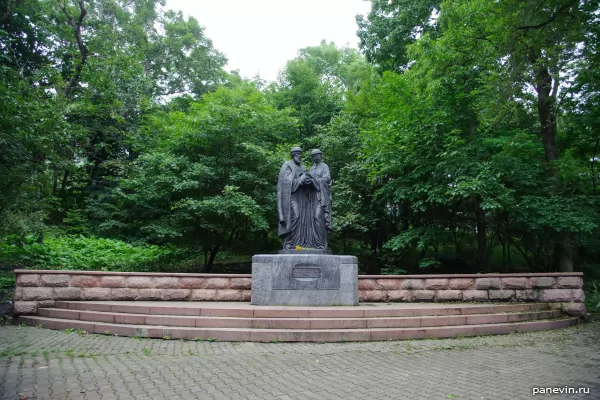
The holy saints Prince Peter and Princess Fevronia of Murom, the sculpture was installed in Vladivostok on July 9, 2011 as part of the national program “In the Circle of the Family”. Pokrovsky park.
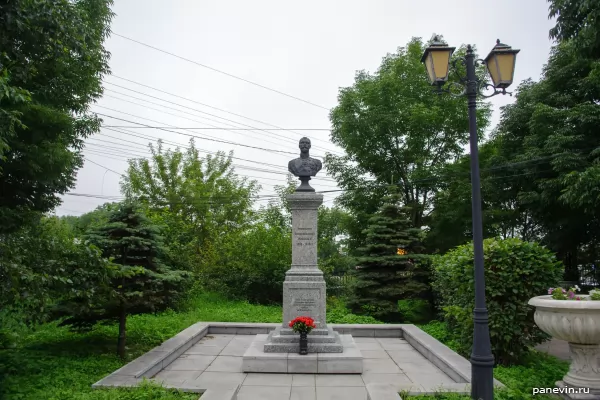
The monument to Emperor Nicholas II was erected in Pokrovsky Square with the money of local monarchists in memory of the visit of the crown prince to Vladivostok in May 1891.
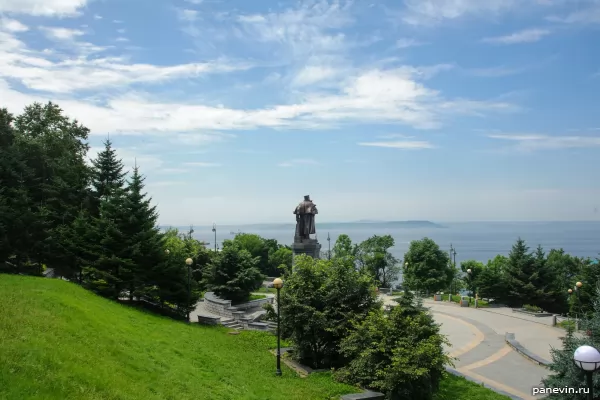
Monument to Admiral Makarov
Monument to Admiral Stepan Osipovich Makarov, opened in 1967.
The authors of the monument are sculptor A. I. Tenet and architect A. Usachev.
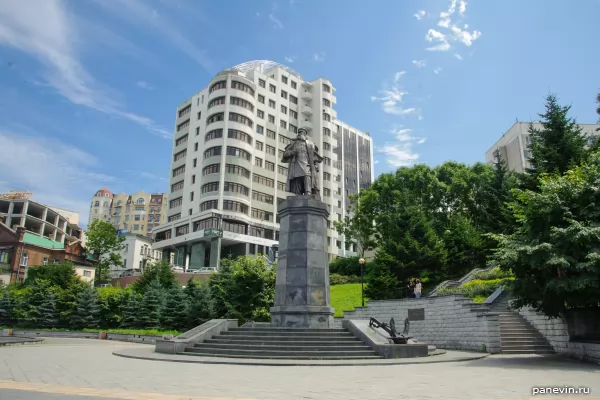
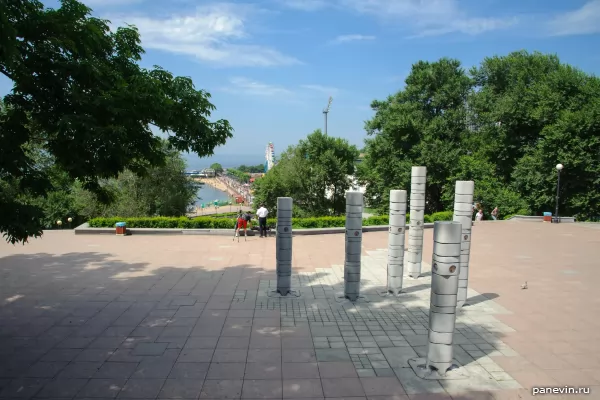
Art object "Seven hills", Vladivostok, square at the light and music fountain.
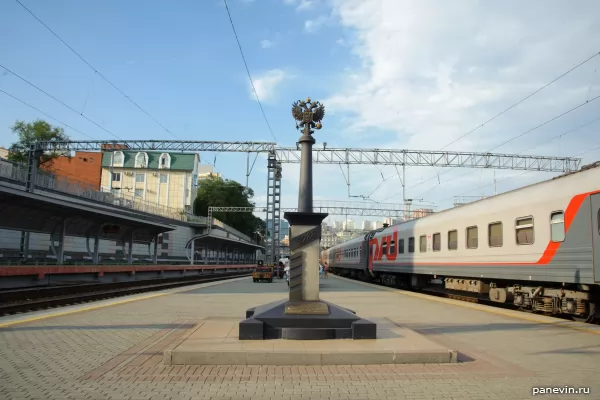
9288th kilometer of the Trans-Siberian Railway, 1st platform of the Vladivostok station.
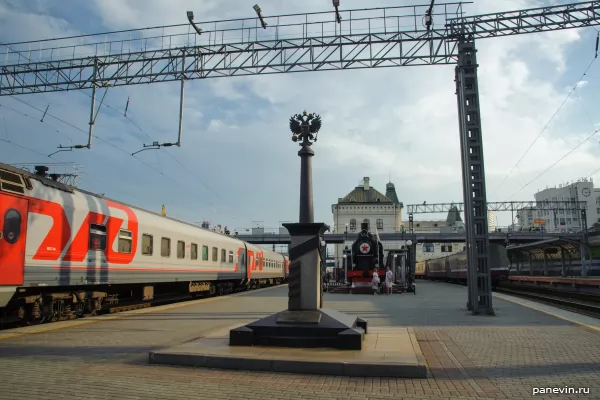

Monument "The feat of arms of the railway workers of Primorye during the Great Patriotic War. "
Steam locomotive EA-3306, produced in the USA in 1944.
It was attributed to the First River depot. Decommissioned in 1995, installed in 1996.
E-series steam locomotives were the main locomotives of the Far Eastern Railways until the 1960s.
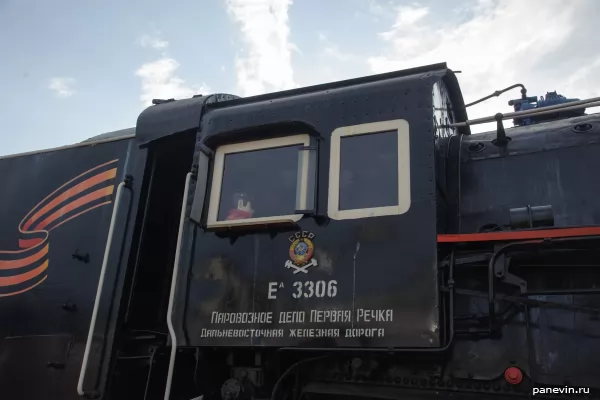
Surprisingly, the windows are not only not covered with metal, as on the vast majority of monument steam locomotives, but inside is a figure of a driver!

Monument to the fighters for power of the Soviets in the central square of Vladivostok. Installed on April 29, 1961. The author is the Honored Art Worker of the RSFSR, the Moscow sculptor Alexey Ilyich Tenet. Architects Kozlov, Usachev, Trautman, Shulgina also worked on the creation of the monument.

The monument to the fighters for the power of the Soviets is one of the symbols of Vladivostok.

The stele "Vladivostok is a city of military glory" on the central square of Vladivostok. Since the coastal city and its fate are inextricably linked with the Pacific Ocean and the Pacific Fleet, there are also bas-reliefs on the marine theme.

Foundation of the city.

Russian-Japanese war.

Civil war in the Far East.

Monument to V.I. Lenin at the Railway Station Square of Vladivostok. It was inaugurated on November 7, 1930.
Authors - sculptor V.V. Kozlov, architect - Yu. Trautman.

Lenin quote on the facade of the building of the General Post Office: "Vladivostok is far away, but our city is ours." It was meant that the Japanese from the Far East must be knocked out.

The Three Whales sculpture in front of the FESKO Hall is a monument to the work of the American sculptor Feiber. This sculpture is dedicated to real events - the rescue of whales by DVMP vessels - the icebreaker Admiral Makarov and the auxiliary vessel Vladimir Arsenyev off the coast of Alaska in 1988. The whale family was captured by ice, and was rescued by the coordinated actions of the crews of these vessels, paving the way for the whales to "clean water".
A monument was made from an old elm.

Bust of A. I. Shchetinina
Monument to Anna Ivanovna Shchetinina - the first woman in the world - the captain of sea navigation, is installed in the square of her name.

The sculpture "Remembering the sailor of foreign travel", Vladivostok, the intersection of Ocean Avenue and the street of Admiral Fokin. The idea of the monument belongs to Ruslan Vakulik, and the residents of Vladivostok actively discussed the appearance of the future monument in social networks, as a result, the sailor is dressed in flared jeans, holds a shopping bag in his hand, and foreign vinyl is pressed to his chest. The statue was opened on January 15, 2013, in memory of the era of the 70-80s, about the first spirit of freedom that sailors from overseas brought from abroad.
The sailor and the name were given - Edik, in honor of one of the heroes of the novel by the seaside writer Lev Knyazev "Time to love."
The sketch of the monument was developed by artists Sergey Merenkov and Georgy Shiroglazov, the sculpture was created by the main artist of Vladivostok, the head of the design department of the city hall Pavel Shugurov.

Composition "I love Vladivostok"

Amur tiger bronze sculpture
The grinning sculpture of the Ussuri tiger stands near the Okean movie theater on 3 Naberezhnaya Street, at the foot of the Tigrovaya Sopka.
The authors are sculptors N.P. Montach and O.O. Kulesh, the sculpture was discovered in 1992.

The sculpture "Tigers" on the Sports Embankment of Vladivostok.
In the “birth certificate” of the cubs, “date and place of birth” - “September 27, 2013, Ussuri taiga” are indicated. The sculptural composition appeared on the initiative of the Amur branch of the World Wide Fund for Nature (WWF).
To return to Vladivostok, you need to rub the ears of the tigers. I rubbed it!

Sundial “Forever Together”, Vladivostok, embankment along Battery Street. Installed on September 15, 2013, the authors are Susanna Mazikina and Alexey Bazaikin.

Monument to the dog nicknamed "Ingus" border guard N. F. Karatsupy
Nikita Fedorovich Karatsupa (04/12/1910-18/11/1994) - Hero of the Soviet Union, colonel of the border service. He is famous for his raids against border violators, during which he used well-trained dogs. In the border troops since 1932. Since 1933, a guide, instructor of service dogs at border posts. Starting service on the border in Primorye, he and his dog, named Ingus (the original name is Hindu), became a real thunderstorm of enemies, detaining 467 intruders, destroying 129 spies and saboteurs, with honor leaving 120 combat clashes. At various times, Karatsupa had five dogs, and they all had one nickname. None of the Ingus was a purebred shepherd, and not one of them died his death - all died from battle wounds, in battles with saboteurs. The monument to the dog Ingus is located in Vladivostok at the Museum of Military Glory of the Pacific Border District.

Cabin of Mi-8T helicopter

A commemorative plaque on the site of the house of the first resident of Vladivostok, Yakov Lazarevich Semenov. Vladivostok, between the houses on Svetlanskaya street 38/40 and 44.

Monument to Eleanor Lord Prey near the house number 41 on Svetlanskaya street. The house of this American, who lived in Vladivostok, was a little higher.

The sculpture "Neptune", Vladivostok, Admiral Square.

Nikolaev Triumphal Gate, Vladivostok, Admiral's Square.
The Arc de Triomphe was built in honor of the arrival of Tsarevich Nikolai in the city in 1891 and demolished in June 1927 by order of the Vladivostok District Executive Committee. In 2002 - 2003, an exact copy was built.


Monument to St. Ilya Muromets, Vladivostok, Admiral's Square. The sculpture was installed in 2012, sculptor: K.M. Zinich.

Guards Red Banner Submarine S-56.

Bust of the Admiral of the Fleet of the Soviet Union N. G. Kuznetsov.

The KTOF Battle Glory memorial ensemble, slabs with a list of those who died during World War II, those who died, the S-56 guards submarine, the tank tower, a ship’s gun, the Eternal Flame.

Memorial plates.

Tank tower (T-34-76) with the B-304 armored boat.

102-mm gun from the destroyer Voikov (Novik series).

Monument to Solzhenitsyn. He arrived in Vladivostok when he returned to the USSR. Opened September 5, 2015.

Monument to submariners of all generations
Caption:
“It was here, on the eastern borders of the country, that the first Russian submarine“ Dolphin ”took up combat duty, and today a new generation of sailors ensures the country's security.”
The monument was erected in the centenary of the Russian submarine fleet in 2005.

The memorial sign at the landing site of the founders of Vladivostok, opened in 1985, sculptor: E. V. Barsegov, architects: D. N. Lavrukhin, B. F. Bogomolov.
On June 20, 1860, 28 soldiers and 2 non-commissioned officers of the 3rd company of the 4th line battalion of Eastern Siberia, under the command of ensign Nikolai Vasilyevich Komarov, landed in the morning on the northern shore of Zolotoy Rog Bay from the Manjur screw transport (commander captain Lieutenant Alexei Karlovich Shefner), put up tents and founded a military post in Vladivostok. The commemorative sign is an obelisk of a parabolic shape, associated in its shape with a wind-blown sail of a marine vessel. The obelisk is made of titanium alloy. Massive stylized anchors made of concrete are installed on both sides of the obelisk.

Memorial ship-monument "Red Pennant", Vladivostok, Ship Embankment, Golden Horn Bay. In the background is the Golden Bridge.
The ship was built in Finland in 1911 as a sail-steam yacht. It was named after the Kamchatka governor and commander of the port of Peter and Paul, Vice Admiral V. S. Zavoyko. Until 1922, the yacht was at the disposal of the governor of Kamchatka, and in 1922 it moved to Vladivostok. In 1923, the yacht was transferred to the class of patrol ships and received the name "Red Pennant." The ship carried out tasks to protect the territorial waters of the Far East, took part in the operations of the Pacific Fleet during the Second World War. On July 28, 1958, the Red Pennant was declared a memorial ship by the Resolution of the Pacific Fleet Military Council and put into eternal parking on the Ship Embankment of the city of Vladivostok.

A memorial sign in honor of hydrographic researchers of the Far Eastern seas, opened in 1987 to commemorate the 130th anniversary of the hydrographic service in front of the building of the Primorsky branch of the Geographical Society. The bell is not just like that - this is the so-called lighthouse bell.

Art object "Primorye", Vladivostok, Admiral Square.

Monument to Sergey Lazo, Vladivostok, Theater Square. Sculptor: L.M. Pisarevsky, the monument was opened in 1945. From 1908 to the 30s of the XX century, on a pedestal was a statue of one of the founders of the city - Admiral Zavoyko.

Monument to Vladimir Vysotsky with a quote from his song: "The closed port of Vladivostok is open." The most amazing thing is that Vysotsky’s songs are heard near the column’s monument!

The grave of the Governor-General of Eastern Siberia Count N. N. Muravyov-Amursky in the square of his name.

Monument to Pushkin, Vladivostok. Installed in 1999 opposite the main building of the Far Eastern State Technical University. Sculptor E.V. Barsegov.

Mass grave of passengers and crew of IL-12 aircraft shot down by Americans
The inscription on the monument: "Here are buried the victims of the robbery attack of American air pirates on the Soviet passenger plane Il-12 July 27, 1953. "
Vladivostok, Zharikovsky Square.

Monument to the Hydrographic Service near the building of the Hydrographic Service of the Pacific Fleet. The monument is made of a navigation sign mounted on water for a special mark. Established in honor of the 140th anniversary of the hydrographic service.
Address: Vladivostok, Svetlanskaya, 80.

Monument to the crew of the schooner "Cruiser", who died during the performance in 1889.
The monument was opened in 1897, Vladivostok, Sailor Square.
It was built on the donations of sailors and officers and was created as a monument to the clipper “Oprichnik” in Kronstadt.
The schooner, under the command of Lieutenant S. S. Rosset, guarded the seal rookeries on Tyuleniy Island from American poachers. After the arrest of the schooner poacher "Rose" under the American flag, the Yankees disabled the compass and the ship crashed into stones. Of the two crews, only one Russian sailor was saved - conductor Vasily Korsuntsev.

Monument to sailors of the 1st Red Banner brigade of torpedo boats 1941-1945
The inscription on the monument: "Sailor boatmen 1 KBTCA, who died the death of the brave in the battles for freedom and independence of our country during the Patriotic War of 1941-1945."
Vladivostok, Sailor Square.

Monument to the heroes of the Russo-Japanese War of 1904-1905 Vladivostok, near the Military-Historical Museum of the Pacific Fleet.
The monument was unveiled on December 16, 2006. It is a figure of the archangel Michael, the patron saint of the heavenly army.

Monument to Admiral G.I. Nevelsky in the park of the same name.

Sculptural composition "Amur cubs"

Monument to the founders of judo
The monument is dedicated to the founder of judo in Russia Vasily Oshchepkov and his Japanese teachers. Opened September 24, 2016.


Monument “Sailors of the merchant fleet. 1941-1945 ”, the embankment of the Golden Horn Bay, the monument was opened in November 1967.

Composition "Noble Courtyard", Vladivostok Ocean Prospect, 15/3. The art object was created by the 33 + 1 community in January 2012.

The holy saints Prince Peter and Princess Fevronia of Murom, the sculpture was installed in Vladivostok on July 9, 2011 as part of the national program “In the Circle of the Family”. Pokrovsky park.

The monument to Emperor Nicholas II was erected in Pokrovsky Square with the money of local monarchists in memory of the visit of the crown prince to Vladivostok in May 1891.

Monument to Admiral Makarov
Monument to Admiral Stepan Osipovich Makarov, opened in 1967.
The authors of the monument are sculptor A. I. Tenet and architect A. Usachev.


Art object "Seven hills", Vladivostok, square at the light and music fountain.

9288th kilometer of the Trans-Siberian Railway, 1st platform of the Vladivostok station.


Monument "The feat of arms of the railway workers of Primorye during the Great Patriotic War. "
Steam locomotive EA-3306, produced in the USA in 1944.
It was attributed to the First River depot. Decommissioned in 1995, installed in 1996.
E-series steam locomotives were the main locomotives of the Far Eastern Railways until the 1960s.

Surprisingly, the windows are not only not covered with metal, as on the vast majority of monument steam locomotives, but inside is a figure of a driver!
Share:
Themes: attractions 134 monuments 72 photos 417 sculpture 71 travel 286 Vladivostok 10
← Blog
pamyatniki_i_skulpturi_vladivostoka
blog










